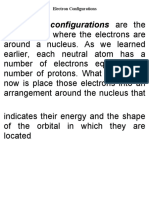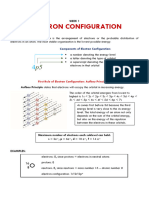0% found this document useful (0 votes)
4 views10 pagesElectron Configuration Explain
The document explains electron configurations, which describe the distribution of electrons in atomic orbitals using standard and abbreviated notations. It outlines principles such as the Aufbau principle, Pauli exclusion principle, and Hund's rule that govern how electrons fill these orbitals. Additionally, it provides examples of electron configurations for various elements and discusses their significance in determining chemical behavior.
Uploaded by
ameenmohamed868Copyright
© © All Rights Reserved
We take content rights seriously. If you suspect this is your content, claim it here.
Available Formats
Download as PDF, TXT or read online on Scribd
0% found this document useful (0 votes)
4 views10 pagesElectron Configuration Explain
The document explains electron configurations, which describe the distribution of electrons in atomic orbitals using standard and abbreviated notations. It outlines principles such as the Aufbau principle, Pauli exclusion principle, and Hund's rule that govern how electrons fill these orbitals. Additionally, it provides examples of electron configurations for various elements and discusses their significance in determining chemical behavior.
Uploaded by
ameenmohamed868Copyright
© © All Rights Reserved
We take content rights seriously. If you suspect this is your content, claim it here.
Available Formats
Download as PDF, TXT or read online on Scribd
/ 10































































































